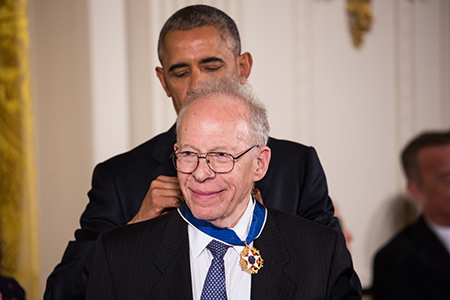"The Arms Control Association’s work is an important resource to legislators and policymakers when contemplating a new policy direction or decision."
Richard L. Garwin (1928-2025)
June 2025
By Raymond Jeanloz
Richard Garwin, who died last month at the age of 97, is best known for designing the 1952 Ivy Mike nuclear explosion test. It vaporized the island of Elugelab in the Eniwetok Atoll and ushered in the U.S. development and deployment of the first hydrogen bombs. Garwin was 24 at the time.

Less widely known is his tireless work in arms control and disarmament. Over more than half a century, he addressed the threats of nuclear weapons and nonproliferation, global war, conflict in space, terrorism, and bioweapons. Garwin participated in security meetings run by the Pugwash Conferences, the International School on Disarmament and Research on Conflicts and Amaldi Global Security starting in the 1970s; served as vice chair of the Federation of American Scientists, which holds an archive of his papers; and chaired the U.S. State Department’s Arms Control and Nonproliferation Advisory Board from 1993 to 2001.
By far his longest association, however, was with the U.S. National Academy of Sciences Committee on International Security and Arms Control (CISAC). He was a member from 1980 to 2023 and an observer thereafter. The committee serves the United States by providing a quiet venue for discussions with foreign technical, military, and policy experts on nuclear, biological, cyber, and space security; arms control; and nonproliferation. This involved regular meetings with Russia, China and India that have been underway for decades.
Garwin contributed significantly to innumerable meetings with these foreign counterparts. He was committed to documenting ideas in writing, coauthoring such CISAC reports as: Nuclear Arms Control: Background and Issues (1985); The Future of the U.S.-Soviet Nuclear Relationship (1991); Monitoring Nuclear Weapons and Nuclear Explosive Materials (2005). He co-wrote Making the Nation Safer: The Role of Science and Technology in Countering Terrorism (2002) after the September 11 attacks.
The National Academy suited him as a venue, as he could emphasize technical matters in discussions bearing on public policy. Garwin was relentless in bringing the logic of engineering and science to each conversation, including on topics that are frightening and therefore emotional. The objective was to provide evidence-based advice, applying the scientific method as vetted by expert peer review.
A focus on technical matters helps initiate arms control discussions. After all, some of the world’s most daunting challenges, such as control of nuclear arsenals, are among the consequences of scientific discovery and the resulting technologies must be understood to be contained. Science and engineering can also provide solutions for arms control, from developing monitoring technologies for verifying treaties to establishing communication channels to avoid crisis.
Garwin brought the international aspects of science to bear, with researchers comparing, competing and, when appropriate, collaborating with each other worldwide. His own scientific collaborators ranged from George Charpak (Megawars and Megatons, 2001) in France to Antonino Zichichi and his Ettore Majorana Centre in Sicily.
More generally, Garwin could appreciate the capabilities of a foreign colleague without needing to agree with the actions or motivations of that individual’s government. This spirit of international technical collaboration made him unusually effective in discussions with counterparts from Russia, China and other nations with which the United States has sustained dialogues. Garwin pointed out unjustified assumptions or flaws in colleagues’ technical analyses as readily as he acknowledged the validity of a point with which he concurred.
The interactions were no less courteous and professional than one would expect for the best of scientific meetings, even when discussions broached topics about unprecedented death and destruction.
Garwin had a special appreciation for the people of China, where he and his wife Lois traveled for more than 40 years. After his first visits in the 1970s, he engaged with scientists and military officers of China’s nuclear-weapons community through CISAC, playing a key role in the production of the English-Chinese, Chinese-English Nuclear Security Glossary (2007). This unique volume is intended to help governments and the arms control community by reducing misunderstandings of concepts and definitions.
His efforts have been appreciated in China as in the United States, with a leading Chinese counterpart writing in 2014, that “Dr. Garwin has contributed enormously to enhance communications, cooperation, and mutual trust, as well as understanding both between the peoples of the two nations and especially the scientists.”
For Garwin, the essential matter is that facts of nature exist independent of humans. Some facts are eventually discovered by humans, often without anticipation, let alone preparation. Yet it is up to humans to decide how to develop, deploy, and ultimately control the resulting technologies to the betterment of humanity.
